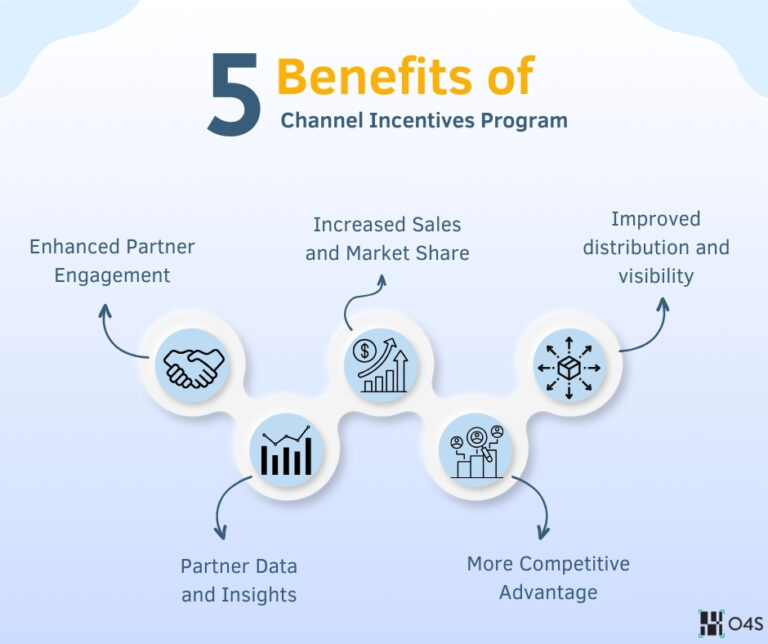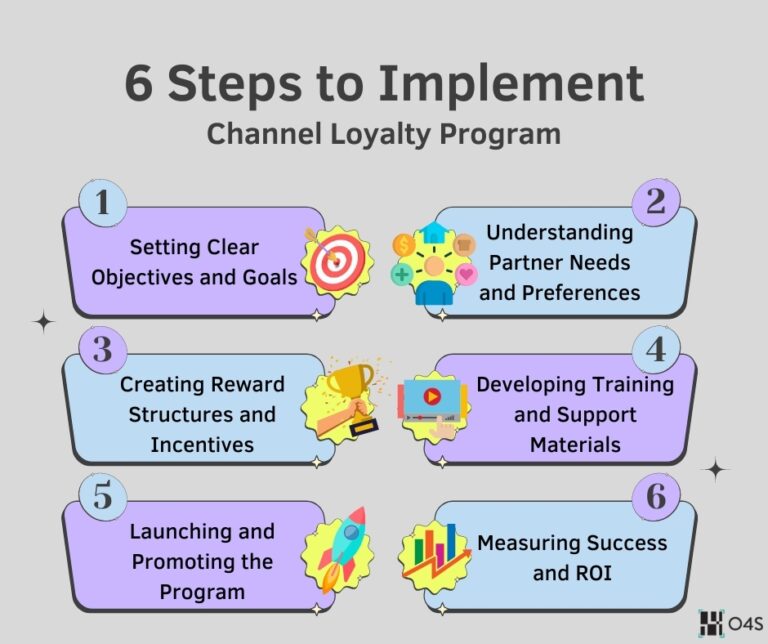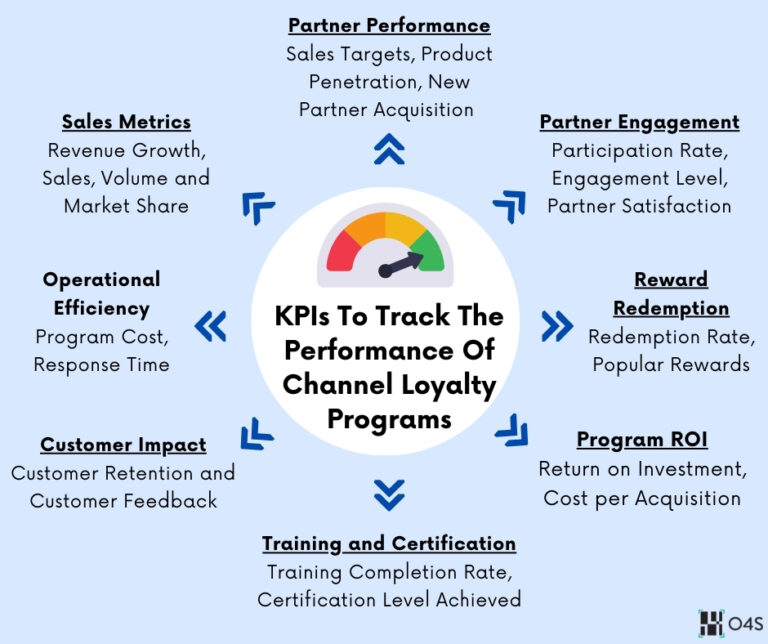Table of Content
- What are channel loyalty programs
- What can’t your brand do without a loyalty program
- Types of channel loyalty programs
- Industries utilizing Channel Loyalty Programs
- Designing and implementing a channel loyalty program
- Choosing the right loyalty rewards
- KPIs to measure the success of your channel loyalty programs
- Industry-specific KPIs to track channel loyalty program performance
- Best practices and tips for success
- Digital channel loyalty program: A mini guide to implementation
- Future trends and outlook
When it comes to expanding the market presence of a consumer product brand, companies most often focus on two things: first, a good branding campaign to make the end consumers aware, and second, solid distribution channels to take their products to the end consumers. To be on the priority list of customer-facing distributors aka channel partners, brands need to nurture and reward these channel partners. This is where the Channel Loyalty Program steps in.
Channel Loyalty Programs are one of the foundational pillars for any consumer product brand, to ensure consistent channel sales. The terminology might differ for different industries but the basic structure is the same: “You make a sale for our brand, and you get a reward. The more sales you make, the better are your rewarding options.”
Some of the different terminologies for Channel Loyalty Program are: Channel Incentives Program, Rewards Program, Influencer Loyalty Program, etc.
What are Channel Loyalty Programs
Channel Loyalty Programs or Rewards Programs are structured schemes designed to incentivize and reward channel partners, retailers, or influencers, for their ongoing loyalty and commitment to a particular brand. These programs aim to enhance partner engagement, drive sales, and foster loyalty by offering various incentives, rewards, and benefits.
What Can’t Your Brand Do Without A Loyalty Program
Channel partners are the ones interacting every day with your target audience. They understand what your consumers prefer and how exactly to pitch the product to sell. While your product head might be a pro at consumer research and building a great product, it’s eventually your channel partners who communicate your product’s USP to the end consumers. So, building a great relationship with these channel partners is a no-brainer.
Here’s what the brands say about the benefits of Channel Incentive Programs:
- Enhanced Partner Engagement: Consumer product companies rely heavily on their network of distributors, retailers, and other channel partners to reach customers effectively. Channel Loyalty Programs incentivize these partners to actively promote and sell your products, leading to increased engagement and collaboration.
- Increased Sales and Market Share: By offering incentives and rewards for achieving sales targets and promoting specific products, Channel Loyalty Programs drive higher sales volumes and market share. Partners prioritize and push your company’s products over competitors’.
- Improved Distribution and Visibility: Channel Loyalty Programs encourage partners to stock and showcase the company’s products prominently in their stores or online platforms. This leads to improved distribution channels and greater visibility for the brand, increasing the likelihood of attracting new customers.
- Partner Data and Insights: Loyalty programs provide companies with valuable data and insights into partner behavior, sales trends, and market preferences.
- Competitive Advantage: Companies that offer attractive rewards and incentives to their partners are more likely to attract and retain top-performing partners, gaining a competitive edge over rivals.

Types of Channel Loyalty Programs
Channel Loyalty Programs can be tailored as per the specific business objectives and partner dynamics.
Common types of Channel Loyalty Programs include:
- Points-Based Programs: In this type of program, partners earn points based on predefined actions or milestones, such as achieving sales targets or completing training modules. These points can then be redeemed for rewards or incentives.
Best suited for: Increasing partner retention and encouraging repeat purchases.
- Tiered Programs: Tiered programs offer different levels of benefits or rewards based on partner performance or status. Partners can progress through various tiers by meeting specific criteria, unlocking increasingly attractive rewards as they advance.
Best suited for: Motivating partners to achieve higher sales targets, driving partner loyalty, and fostering healthy competition among sales teams.
- Rebate Programs: Rebate programs provide partners with financial incentives based on their performance or sales volume over a specified period. Rebates may be offered as a percentage of sales or as fixed amounts for achieving certain milestones.
Best suited for: Encouraging partners to focus on selling high-margin products and maximizing profitability.
- Co-Op Programs: Co-Op programs involve collaboration between companies and their partners to fund joint marketing initiatives or promotional activities. Partners contribute funds or resources, which are then matched or supplemented by the company to drive mutual growth.
Best suited for: Expanding brand awareness and capturing new market segments through strategic marketing partnerships.
- Performance-Based Programs: Performance-based programs reward partners based on their achievement of predefined performance metrics, such as sales targets, customer satisfaction scores, or market share growth. Partners receive incentives or bonuses for surpassing set goals.
Best suited for: Aligning partner incentives with company objectives and driving overall business growth.
.
Industries Utilizing Channel Loyalty Programs
Channel Loyalty Programs are prevalent across almost all industries catering to consumers via distribution channels. Here are a few of the prominent industries using channel loyalty programs:
Electronics and Electrical goods: Reseller and Electrician Loyalty Programs
In this industry, Channel Loyalty Programs are often used to incentivize distributors, resellers, sales representatives, and electricians to promote and sell the company’s products over competitors.
Consumer Goods and Retail: Retailer and Distributor Loyalty Programs
In the consumer goods and retail sector, Channel Loyalty Programs are employed to strengthen relationships with retailers, wholesalers, and distributors. These programs encourage partners to prioritize the company’s products on store shelves, offer special promotions to customers, and provide valuable feedback on market trends and consumer preferences.
Automotive and Aftermarkets: Workshop and Mechanics Loyalty Program
Automotive manufacturers, workshops, mechanics, and dealerships leverage Channel Loyalty Programs to drive sales of vehicles, parts, and accessories through their network of dealers and distributors. These programs may offer incentives for meeting sales quotas, upselling add-on services, or participating in co-branded marketing campaigns.
Manufacturing and Industrial: Distributors and Contractor Loyalty Program
Manufacturers and industrial suppliers utilize Channel Loyalty Programs to incentivize distributors, contractors, and suppliers to promote and sell their products in various industries. These programs may offer rebates for volume purchases, discounts on bulk orders, or co-marketing opportunities to drive mutual growth and profitability.
Building Materials: Technician and Influencer Loyalty Program
In the building materials industry, which includes products like paints, plywood, cement, glass, sanitaryware, and construction materials, Channel Loyalty Programs are essential for engaging distributors, contractors, retailers, and influencers. These programs incentivize partners to prioritize the company’s products in construction projects, offer training on product features and applications, and provide marketing support to drive sales and market share growth.
Seeds, Fertilizers, and Agri-Inputs: Retailer and Farmer Loyalty Program
The agri-inputs sector, encompassing fertilizers and seeds, relies on Channel Loyalty Programs to strengthen relationships with agricultural retailers, distributors, and farmers. These programs offer incentives for promoting and selling the company’s agricultural products, provide agronomic support and training to retailers and farmers, and facilitate access to innovative technologies and solutions for improved crop yield and sustainability.
Designing and Implementing a Channel Loyalty Program
The design and implementation of a Channel Loyalty Program require careful planning and execution. The key steps in this process include:
- Setting Clear Objectives and Goals: Define the specific objectives and goals of the Channel Loyalty Program, such as increasing sales revenue, improving partner engagement, or expanding market reach.
- Understanding Partner Needs and Preferences: Conduct research and engage with partners to understand their preferences, challenges, and motivations. Tailor the program to address partner needs effectively and align incentives with their priorities.
- Creating Reward Structures and Incentives: Develop a comprehensive reward structure that offers incentives aligned with partner behavior and performance objectives. Balance short-term incentives with long-term rewards to encourage sustained engagement.
- Developing Training and Support Materials: Provide partners with the necessary training, resources, and support to help them succeed in the program. Develop training materials, guides, and online resources to facilitate partner onboarding and ongoing education.
- Launching and Promoting the Program: Execute a well-planned launch strategy to generate excitement and engagement among partners. Utilize multiple communication channels to promote the program and educate partners about its benefits and rewards.
- Measuring Success and ROI: Implement robust measurement and tracking mechanisms to evaluate the success and ROI of the Channel Loyalty Program. Monitor key performance indicators (KPIs) such as sales metrics, partner satisfaction, and ROI to assess program effectiveness and identify areas for improvement.

Choosing the Right Loyalty Rewards
Selecting appropriate rewards is crucial for the success of Channel Loyalty Programs. The rewards must align with the channel partner’s motivation and needs.
Common partner reward options include:
- Cash Incentives: Cash incentives provide partners with direct financial rewards for their performance or contributions. These incentives can either be bonuses, commissions, or monetary awards, offering partners tangible motivation for their efforts.
- Discounts and Rebates: Discounts and rebates allow partners to procure products or services at reduced prices or receive refunds based on their purchase volume or performance. These incentives incentivize partner loyalty and encourage increased sales.
- Exclusive Products or Services: Offering exclusive access to products or services not available to the general public can motivate partners. Exclusive offerings provide partners with added value and a competitive edge in the market.
- Travel and Experiences: Travel incentives, such as trips, vacations, or experiential rewards, offer partners memorable experiences as a reward for their achievements. These incentives can serve as powerful motivators and foster a sense of recognition and appreciation.
- Recognition and Awards: Recognizing partner achievements through awards and public acknowledgment is a non-monetary way to incentivize performance. Public recognition reinforces positive behavior and fosters a sense of pride and belonging among partners.
KPIs to Measure the Success of Your Channel Loyalty Programs
Brands can track the following KPIs to assess the performance of their Channel Loyalty Programs.
- Sales Metrics:
Revenue Growth: Track the increase in sales revenue generated by channel partners participating in the loyalty program
Sales Volume: Measure the total number of units or products sold through channel partners
Market Share: Evaluate changes in market share within the industry as influenced by the loyalty program.
- Partner Performance:
Achievement of Sales Targets: Monitor the percentage of partners meeting or exceeding their sales targets.
Product Penetration: Assess the variety and depth of products sold by each partner.
New Partner Acquisition: Track the number of new partners brought into the program.
- Partner Engagement and Satisfaction:
Participation Rate: Measure the percentage of eligible partners actively participating in the program.
Engagement Level: Evaluate how often partners engage with program activities, such as attending training or redeeming rewards.
Partner Satisfaction: Use surveys and feedback mechanisms to gauge partner satisfaction with the program.
- Reward Redemption:
Redemption Rate: Track the percentage of earned rewards that partners redeem.
Popular Rewards: Identify which rewards are most frequently selected by partners.
- Program ROI:
Return on Investment (ROI): Calculate the financial return of the program relative to its costs.
Cost per Acquisition: Measure the cost of acquiring new partners or customers through the program.
- Training and Certification:
Training Completion Rate: Track the percentage of partners completing required training modules.
Certification Levels Achieved: Measure the number of partners achieving various certification levels.
- Customer Impact:
Customer Retention: Assess the impact of the program on customer retention rates, driven by improved partner performance.
Customer Satisfaction and Feedback: Collect feedback from end customers regarding their experience with channel partners.
- Operational Efficiency:
Program Administration Costs: Monitor the costs associated with managing the loyalty program.
Response Time: Measure the efficiency of program support, including response times to partner inquiries and reward processing.

Industry-specific KPIs to track Channel Loyalty Program Performance
Besides these, you can also measure certain industry-specific KPIs to track the performance of your loyalty programs:
Electronics Industry
New Product Sales: Measure the effectiveness of partners in promoting and selling new products.
Consumer Goods and Retail
Shelf Space Allocation: Assess the amount of shelf space dedicated to the brand’s products in retail stores.
Automotive
Service Upsell Rates: Measure the success of partners in upselling new parts and service packages.
Building Materials
Project Wins: Measure the number of projects secured through partner engagement.
Contractor Loyalty: Track the retention and loyalty of contractors and builders.
Agri-Inputs
Seasonal Sales Increases: Measure sales increases during peak agricultural seasons.
By tracking these KPIs, brands can effectively evaluate the performance of their Channel Loyalty Programs and make data-driven adjustments to enhance their effectiveness.
Best Practices and Tips for Success
Following best practices is essential for maximizing the effectiveness of Channel Loyalty Programs. Key considerations include:
- Setting Realistic Expectations: Establish realistic goals and timelines for the Channel Loyalty Program, taking into account factors such as partner dynamics, market conditions, and resource constraints.
- Regular Communication and Feedback: Maintain regular communication with partners to keep them informed about program updates, incentives, and opportunities. Take feedback from partners to keep upgrading and improving the program.
- Adapting to Changing Market Dynamics: Stay agile and adaptable in response to changing market trends, competitor actions, and partner needs.
- Staying Compliant with Regulations: Ensure compliance with relevant laws, regulations, and industry standards including data privacy, rewards to cash redemption, etc.
- Digitalise your Loyalty Programs: Instead of manually running loyalty programs and relying on physical coupons or rewards, digitalize them using channel loyalty software. This will not just increase efficiency but also ensure accuracy and transparency with the channel partners.
Digital Channel Loyalty Program: A Mini Guide to Implementation
Digital Channel Loyalty Platform helps you escape the hassle of managing schemes manually on the excel sheets, printing and distributing physical coupons, and manual rewards distribution. The platform brings together everything in one window both for the channel partners and stakeholders within the brand.
Key Features of Digital Channel Loyalty Platform
- Program Management:
- Automated Enrollment: Simplifies the process of enrolling partners into the loyalty program.
- Rule Configuration: Allows customization of rules and criteria for earning rewards based on sales targets, product promotions, or other performance metrics.
- Tier Management: Supports the creation and management of tiered programs with different levels of benefits.
- Rewards and Incentives:
- Point Allocation: Automatically allocates points to partners based on predefined actions or milestones.
- Reward Catalog: Provides a diverse catalog of redeemable rewards, including cash incentives, discounts, exclusive products, and experiences.
- Instant Redemption: Enables partners to redeem rewards instantly through the platform.
- Training and Support:
- E-Learning Modules: Offers online training modules to educate partners about products, sales strategies, and program details.
- Certification Programs: Tracks completion of training and certification programs to ensure partner competency.
- Communication and Engagement:
- Targeted Messaging: Facilitates personalized communication with partners through emails, notifications, and in-app messages.
- Feedback Mechanism: Allows partners to provide feedback and suggestions, enhancing program engagement.
- Performance Tracking and Analytics:
- Real-Time Dashboards: Provides real-time dashboards to track partner performance, sales metrics, and reward redemption.
- Advanced Analytics: Offers insights into program effectiveness, partner behavior, and ROI through data analytics.
- Integration Capabilities:
- CRM Integration: Integrates with Customer Relationship Management (CRM) systems to synchronize partner data and streamline operations.
- ERP Integration: Connects with Enterprise Resource Planning (ERP) systems for seamless management of sales data and financial transactions.
Benefits of Digital Incentives Program
- Efficiency and Scalability:
- Automates administrative tasks, reducing manual effort and errors.
- Scales easily to accommodate growing partner networks and program complexity.
- Enhanced Partner Engagement:
- Provides a user-friendly interface for partners to track their progress, redeem rewards, and access training materials.
- Increases engagement through personalized communication and timely recognition of achievements.
- Improved Data Accuracy and Insights:
- Centralizes data collection, ensuring accurate and up-to-date information.
- Delivers actionable insights to optimize program strategies and partner performance.
- Cost-Effectiveness:
- Reduces costs associated with manual program management and traditional reward distribution.
- Maximizes ROI by targeting incentives effectively and minimizing administrative overhead.
- Flexibility and Customization:
- Allows for the customization of program rules, rewards, and communication strategies to align with specific business goals and partner needs.
- Adapts to changing market conditions and partner expectations.
By leveraging advanced technology and data-driven insights, these platforms enhance the overall effectiveness and efficiency of Channel Loyalty Programs.
O4S provides channel loyalty platform with consisting all these features and seamless integration capabilities. It provides dashboard for the brand marketing experts to design and launch loyalty schemes, and an app for the channel partners to scan QR codes and earn points which can later on be redeemed as rewards. 100+ brands are using O4S platform, and have achieved 20% increase in channel sales revenue and decreased partner attrition significantly.
Curious to know how O4S platform works? Sign up for a demo
Future Trends and Outlook
The future of Channel Loyalty Programs is marked by several emerging trends, including:
- Personalization and Customization: Leveraging data analytics and AI technologies, companies can deliver targeted incentives and rewards that resonate with partners on a personal level.
- Integration with AI and Machine Learning: It will enable companies to gain deeper insights into partner behavior, predict trends, and optimize program performance in real time.
- Expansion into Emerging Markets: If companies seek to expand their global footprint, localization, cultural sensitivity, and market-specific strategies will be essential for success in diverse geographic regions.
Channel Loyalty Programs will continue to evolve in this fast-paced digitalisation economy. These programs are meant to nurture personal relationships and there’s no technology that can replace this. So, embrace digitalisation and AI to build a the channel incentive program with tailored rewards. Let’s together build your brand ambassadors.



